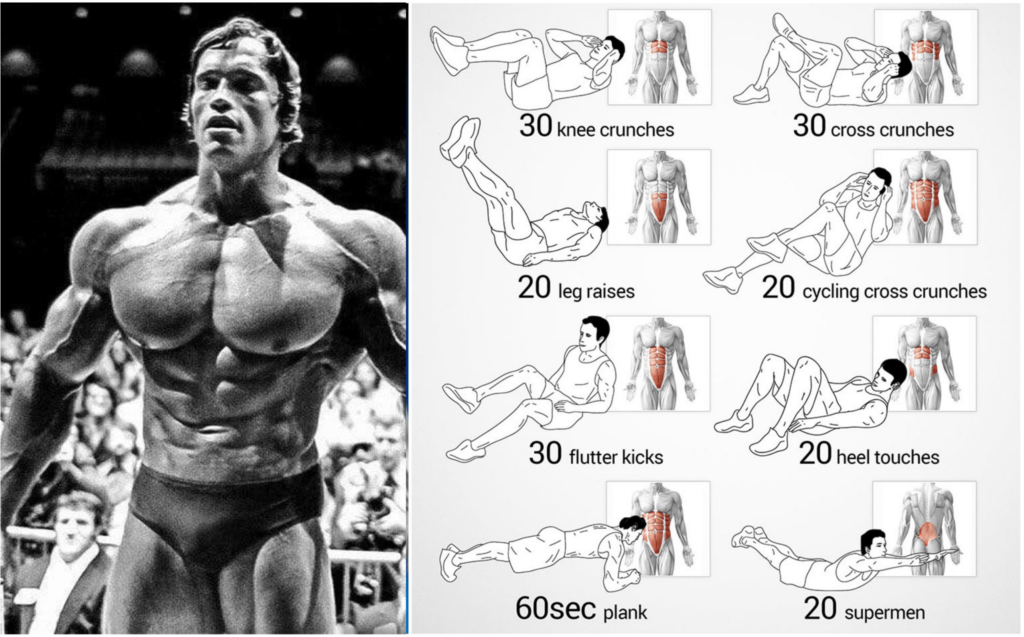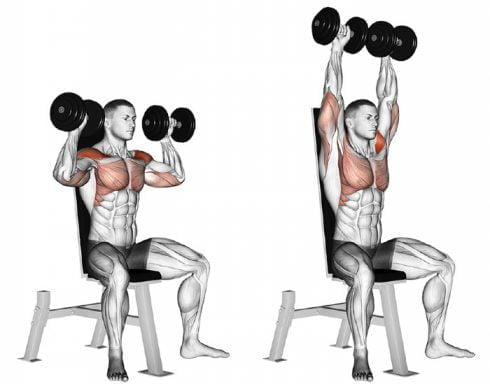Introduction
Weightlifting is a form of exercise that involves lifting weights, either free weights or machines, to build strength and muscle mass. It’s a popular form of exercise for beginners who want to improve their physical fitness and for athletes looking to enhance their sports performance.
There are several benefits of weightlifting for beginners, including:
- Building strength and muscle mass: Weightlifting is an effective way to build muscle and increase strength, which can help with everyday activities and improve overall physical fitness.
- Burning calories: Weightlifting can help burn calories and promote weight loss, as muscle burns more calories than fat.
- Boosting metabolism: Weightlifting can increase metabolism, which can help burn calories even when you’re not exercising.
- Improving bone health: Weightlifting can help improve bone density, reducing the risk of fractures and osteoporosis.
However, it’s important to use proper form and technique when weightlifting to avoid injury. This includes using the appropriate weight for your fitness level, maintaining good posture throughout each exercise, and avoiding jerking or swinging motions that can stress your joints. Following these beginner weightlifting tips can safely and effectively improve your physical fitness.
Setting Goals
Setting specific and achievable goals is a crucial step for beginners in weightlifting. Without clear goals, it can be challenging to track progress and stay motivated. When setting goals, it’s important to keep them realistic and achievable. Setting overly ambitious goals can lead to frustration and disappointment if they are not achieved.
For beginners, goals can vary depending on their fitness level and individual needs. Some examples of beginner weightlifting goals may include:
- Increasing strength and muscle mass
- Improving overall fitness and endurance
- Losing weight or reducing body fat percentage
- Mastering proper form and technique for basic weightlifting exercises
To make goals more specific and achievable, it’s important to break them down into smaller, manageable steps. For example, if a beginner’s goal is to increase their strength, they could start with a specific weightlifting exercise and aim to gradually increase the weight they lift over time. Setting weekly or monthly targets can help keep them motivated and track their progress.
Another important aspect of goal-setting is to make them measurable. This means using specific metrics to track progress, such as tracking weight lifted, body weight, or body fat percentage. This can help beginners see how far they’ve come and provide a sense of accomplishment, which can further motivate them to continue their weightlifting journey.
In conclusion, setting specific and achievable goals is a critical step for beginners in weightlifting. By breaking down goals into smaller, manageable steps, using measurable metrics, and staying realistic, beginners can track their progress and stay motivated throughout their fitness journey.
Warm-Up
As a beginner weightlifter, it’s crucial to warm up your body properly before starting your workout routine. Warming up helps to prepare your muscles, joints, and nervous system for the upcoming physical activity, reducing the risk of injury and improving your overall performance.
Dynamic stretching exercises are an essential part of a good warm-up routine. Unlike static stretching, which involves holding a stretch for a prolonged period, dynamic stretching involves continuous movement, increasing your heart rate and blood flow to the muscles. This type of stretching helps to improve flexibility, range of motion, and neuromuscular control, which can reduce the risk of injury and improve your lifting technique.
Here are some dynamic stretching exercises that you can include in your warm-up routine:
- Leg swings: Stand facing a wall or a sturdy object and swing one leg forward and backward, then side to side, for 10 to 12 repetitions. Repeat with the other leg.
- Hip circles: Stand with your feet shoulder-width apart and hands on your hips. Circle your hips clockwise for 10 to 12 reps, then repeat counterclockwise.
- Arm circles: Stand with your feet shoulder-width apart and arms extended out to the sides. Circle your arms clockwise for 10 to 12 reps, then repeat counterclockwise.
- High knees: Stand with your feet shoulder-width apart and raise one knee to hip height, then alternate legs for 10 to 12 reps.
- Walking lunges: Take a big step forward with one leg and lower your body until your back knee is just above the ground. Step forward with your other leg and repeat for 10 to 12 reps.
Remember to start with light intensity and gradually increase the difficulty of your warm-up exercises as you progress in your weightlifting journey. A good warm-up routine should take at least 5 to 10 minutes and should leave you feeling ready and energized for your workout. By incorporating dynamic stretching into your warm-up routine, you’ll be setting yourself up for a safe and effective weightlifting experience.
Basic Weightlifting Exercises
Here are the 8 basic weightlifting exercises for beginners and how to perform them with proper form and technique:
1. Squats
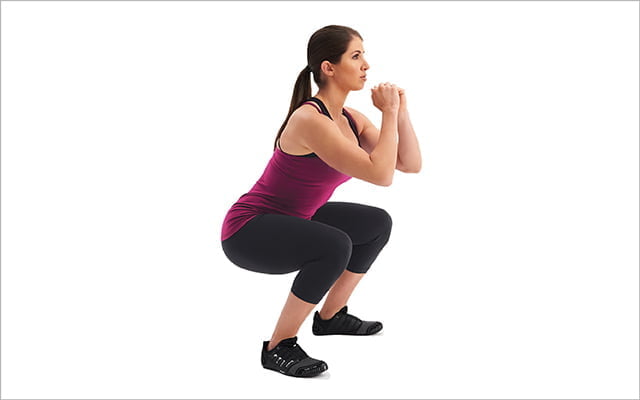
Squats are a fundamental lower body exercise that targets the quadriceps, hamstrings, glutes, and lower back.
Here’s how to perform a squat:
- Stand with your feet shoulder-width apart, toes pointing slightly outward.
- Keep your chest up and your back straight.
- Lower your body by pushing your hips back and bending your knees until your thighs are parallel to the ground.
- Push through your heels and extend your legs to return to the starting position.
Tips: Maintain proper form by keeping your knees aligned with your toes, and don’t let them go past your toes. Use a mirror or have a spotter to check your form and ensure safety.
2. Deadlifts
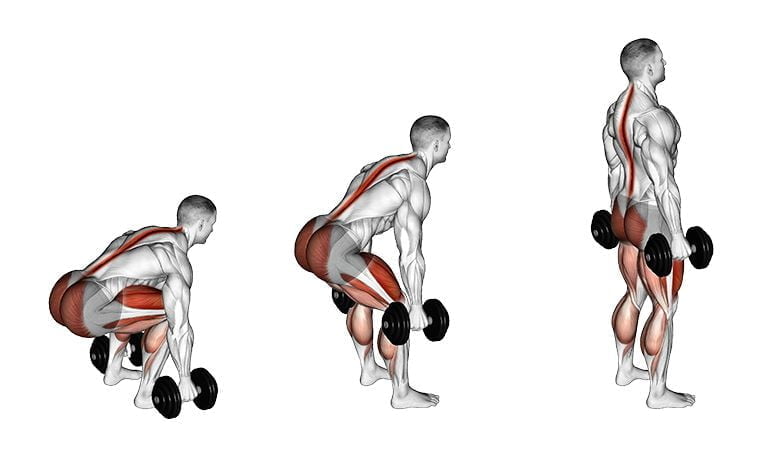
Deadlifts work the lower back, glutes, hamstrings, and also engage the core and upper body muscles.
Here’s how to perform a deadlift:
- Stand with your feet shoulder-width apart and toes pointing slightly outward.
- Place your hands on the barbell with an overhand or mixed grip.
- Keep your chest up and your back straight.
- Lift the barbell off the ground by pushing your hips back and extending your legs.
- Lower the barbell to the ground by bending your knees and pushing your hips back.
Tips: Keep the bar close to your body throughout the movement to reduce strain on the lower back. Engage your core to stabilize your spine and never round your back.
3. Bench Press
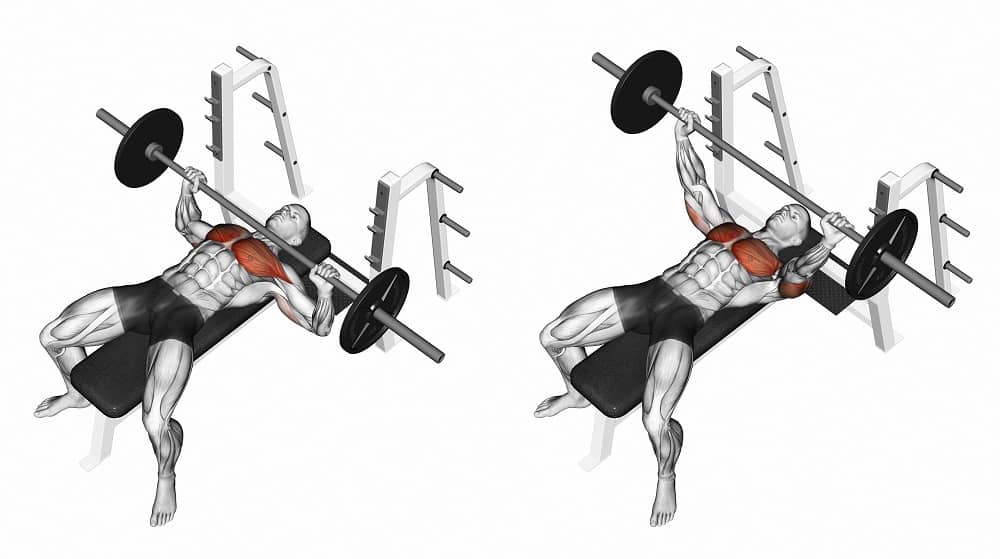
The bench press primarily targets the chest, shoulders, and triceps, making it a key upper-body strength exercise.
Here’s how to perform a bench press:
- Lie on a flat bench with your feet on the ground.
- Grab the barbell with a grip that is slightly wider than shoulder-width apart.
- Lower the barbell to your chest while keeping your elbows close to your body.
- Push the barbell back up to the starting position.
Tips: Use a spotter for heavy lifts. Maintain a slight arch in your lower back and keep your shoulder blades squeezed together for stability. Control the bar throughout the movement, and avoid bouncing it off your chest.
4. Overhead Press
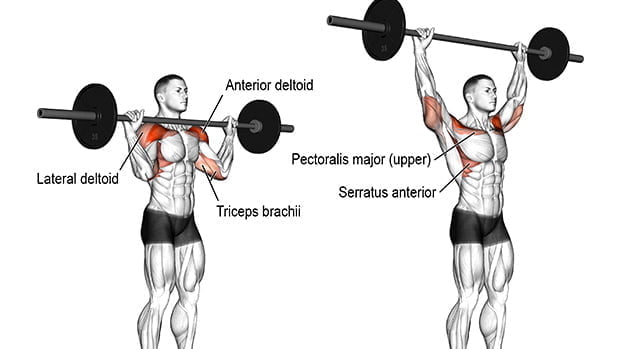
This exercise targets the shoulders and triceps, improving upper body strength and stability.
Here’s how to perform an overhead press:
- Stand with your feet shoulder-width apart and hold the barbell with a grip that is slightly wider than shoulder-width apart.
- Bring the barbell to your shoulders with your elbows pointing forward.
- Press the barbell up and over your head.
- Lower the barbell back down to your shoulders.
Tips: Keep your core engaged and avoid leaning back excessively. Use proper form to prevent shoulder strain.
5. Barbell Rows

Barbell rows target the upper back and biceps while also engaging the core for stability.
Here’s how to perform a row:
- Stand with your feet shoulder-width apart and hold the barbell with an overhand grip.
- Bend your knees slightly and lean forward while keeping your back straight.
- Pull the barbell up towards your chest by bending your elbows and squeezing your shoulder blades together.
- Lower the barbell back down to the starting position.
Tips: Maintain a neutral spine and avoid using momentum. Focus on squeezing your shoulder blades together as you lift the bar.
6. Pull-Ups

Pull-ups are a bodyweight exercise that targets the upper back, biceps, and shoulders.
Here’s how to perform a pull-up:
- Grab the pull-up bar with an overhand grip that is slightly wider than shoulder-width apart.
- Hang from the bar with your arms fully extended and your feet off the ground.
- Pull your body up towards the bar by bending your elbows and squeezing your shoulder blades together.
- Lower your body back down to the starting position.
Tips: Engage your core to avoid swinging. If you can’t do a full pull-up, start with assisted pull-up machines or resistance bands to build strength gradually.
7. Dips

Dips are an effective compound exercise that primarily targets the triceps, chest, and shoulders while also engaging the core and upper body.
Here’s how to perform a dip:
- Stand between two parallel bars.
- Place your hands on the bars with your palms facing down and your fingers pointing forward.
- Lift your body off the ground and straighten your arms.
- Lower your body by bending your elbows until your upper arms are parallel to the ground.
- Push your body back up to the starting position.
Tips: Keep your torso upright and avoid leaning too far forward or backward. Focus on controlled movements, and use a spotter or assistance if needed when starting out.
8. Lunges
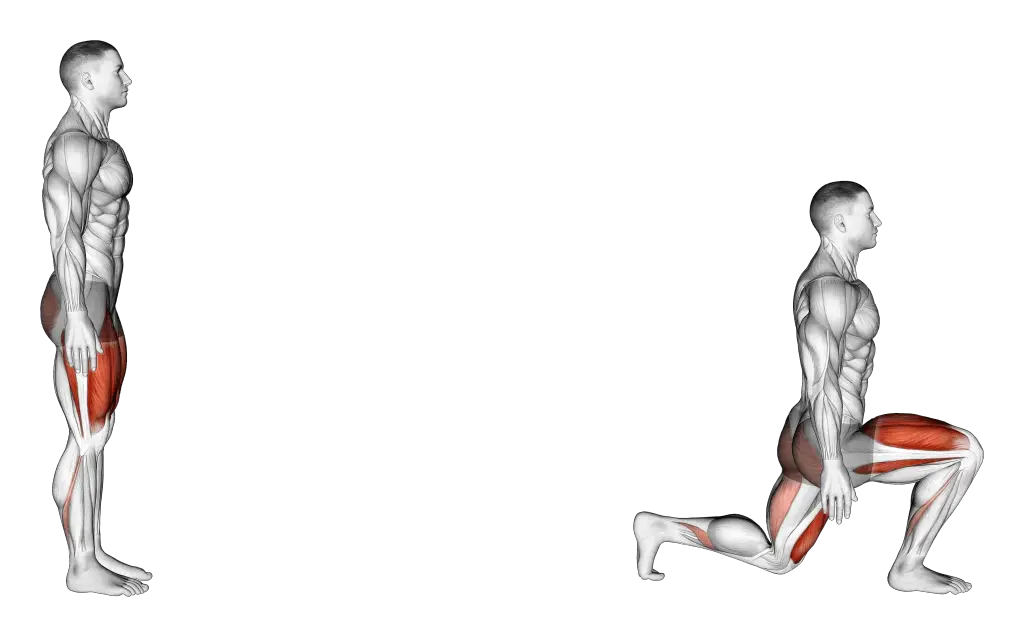
Lunges are a versatile lower body exercise that targets the quadriceps, hamstrings, glutes, and calves while also improving balance and stability.
Here’s how to perform a lunge:
- Stand with your feet shoulder-width apart.
- Take a big step forward with one leg and lower your body until your back knee is just above the ground.
- Push through your front heel and step back to the starting position.
Tips: Keep your upper body upright, and don’t let your front knee extend past your toes to prevent knee strain. Start with bodyweight lunges and then progress to using weights or dumbbells for added resistance.
It’s important to note that these exercises can be modified based on your fitness level and ability. As a beginner, it’s recommended to start with light weights and focus on perfecting your form and technique before increasing the weight.
Additionally, it’s important to incorporate rest days into your weightlifting routine to allow your muscles to recover and prevent injury. A good rule of thumb is to aim for at least one day of rest between weightlifting sessions.
Strength Training Program
When starting a weightlifting routine, it’s important to follow a structured strength training program that gradually increases the weight and intensity of your workouts. This helps you avoid injury and allows your muscles to adapt and grow stronger over time.
A good beginner strength training program typically involves performing each exercise for 3-4 sets of 8-12 reps. This rep range is ideal for building muscle and improving overall strength.
Rest periods are also important to consider. As a beginner, it’s recommended to take 1-2 minutes of rest between sets. This allows your muscles to recover and prepare for the next set, improving your overall performance and reducing the risk of injury.
As you progress in your weightlifting routine, it’s important to track your progress and gradually increase the weight you lift. This is known as progression tracking, and it helps ensure that you continue to challenge your muscles and see improvements over time. You can increase the weight by small increments (e.g. 5 lbs) each week or every other week.
In summary, a structured strength training program for beginners involves performing 3-4 sets of 8-12 reps for each exercise, taking 1-2 minutes of rest between sets, and tracking your progress and gradually increasing the weight you lift over time. By following these guidelines, you can build muscle and improve your overall strength safely and effectively.
Nutrition and Rest
Proper nutrition and rest are essential for muscle recovery and growth, especially for beginners who are just starting their weightlifting journey. When you lift weights, you create small tears in your muscles, and the process of repairing those tears is what leads to muscle growth. This repair process requires adequate nutrition and rest.
Protein is a crucial nutrient for building and repairing muscles. As a beginner weightlifter, it’s recommended to consume 1.2 to 1.5 grams of protein per kilogram of body weight per day. So, if you weigh 68 kilograms (150 pounds), you should aim for 82 to 102 grams of protein per day. Good sources of protein include chicken, turkey, beef, fish, eggs, dairy products, legumes, and nuts.
In addition to protein, you’ll also need to make sure you’re getting enough carbohydrates and healthy fats to provide energy for your workouts and support overall health. Whole foods like fruits, vegetables, whole grains, and healthy fats such as olive oil and avocado are great choices.
Rest is also critical for muscle recovery and growth. When you lift weights, you create stress on your muscles and nervous system, and rest allows your body to repair and adapt to that stress. As a beginner weightlifter, aim for at least seven to eight hours of sleep per night to promote muscle recovery.
Another important aspect of rest is allowing your muscles enough time to recover between workouts. When you strength train, you create micro-tears in your muscles, and it takes time for them to heal and grow stronger. So, schedule rest days into your workout routine to give your muscles time to recover.
Common Mistakes to Avoid
Here are 8 common mistakes that beginner weightlifters should avoid:
- Lifting too much weight too soon – It’s important to start with lighter weights and gradually increase the weight as you become stronger and more comfortable with the exercises. Lifting too much weight too soon can lead to injuries.
- Neglecting proper form and technique – Proper form and technique are essential to prevent injuries and maximize the effectiveness of your workouts. Take the time to learn how to perform each exercise correctly.
- Not using a full range of motion – It’s important to perform each exercise through a full range of motion to ensure that you’re engaging all of the muscles in the targeted area.
- Skipping warm-up and cool-down – Warming up before your workout can help prevent injuries and improve your performance, while a proper cool-down can help your muscles recover and reduce soreness.
- Ignoring pain or discomfort – If you experience pain or discomfort during a workout, stop immediately and assess the situation. Continuing to exercise through pain can lead to serious injuries.
- Not tracking progress – Tracking your progress can help you stay motivated and ensure that you’re making progress toward your goals. Use a workout log or app to keep track of your sets, reps, and weights.
- Overtraining – It’s important to give your muscles time to rest and recover between workouts. Overtraining can lead to fatigue, injuries, and a lack of progress.
- Neglecting nutrition and rest – Proper nutrition and rest are crucial for muscle recovery and growth. Be sure to fuel your body with the right nutrients and get enough sleep to support your weightlifting goals.

By avoiding these common mistakes, beginner weightlifters can stay safe, make progress, and achieve their fitness goals.
Conclusion
In conclusion, weightlifting can be an incredibly effective way for beginners to build strength, increase muscle mass, and improve overall fitness. To summarize the beginner weightlifting tips we’ve covered:
- Set specific and achievable goals
- Warm up properly before weightlifting
- Focus on basic weightlifting exercises with proper form and technique
- Follow a structured strength training program
- Get adequate nutrition and rest for muscle recovery and growth
- Avoid common mistakes such as lifting too much weight too soon and neglecting proper form and technique.
Remember, the key to success in weightlifting is consistency, dedication, and patience. Don’t get discouraged by slow progress, and keep working towards your goals. With time and effort, you’ll see results and achieve the fitness level you desire. So, start weightlifting today and take the first step towards a healthier, stronger you!

Good day, and welcome to Fitthour. My name is Shubham Vijay, and I am a certified personal trainer and nutrition coach with 6 years of experience in the fitness industry. At Fitthour, we specialize in types of training, such as strength training, cardio, or HIIT, and our mission is to help clients achieve their fitness goals and improve their overall health.

